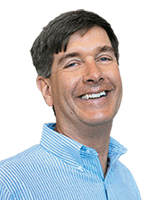Clark Talks Turf: Controlling basidiomycete fungi with Pedigree

Clark Throssell
Brian Aynardi, Ph.D., is a turfgrass pathologist and leads the fungicide development effort at PBI-Gordon as the company’s Northeast research scientist. You may reach Brian at baynardi@pbigordon.com for more information.
Q: Provide a brief history of Pedigree and its active ingredient, flutolanil.
Pedigree is a non-generic, SC (soluble concentrate) formulation of flutolanil. Flutolanil was discovered in the mid-1980s by Nihon Nohyaku, the parent company of the current supplier, Nichino America, and was the original SDHI fungicide. It is in FRAC (Fungicide Resistance Action Committee) Group 7.
Flutolanil is a single-site mode of action fungicide and will control only basidiomycete fungi. Pedigree will be available Oct. 1, 2018 as part of the early order program.
Q: What diseases is Pedigree most effective in controlling?
Pedigree is the gold standard for controlling brown patch (Rhizoctonia solani), large patch (Rhizoctonia solani) and fairy ring (caused by basidiomycete fungi). Flutolanil is the go-to active ingredient for these diseases.
Other diseases in the Rhizoctonia group such as brown ring patch, red thread, pink patch and southern blight also are effectively controlled by Pedigree.
We are excited about the control Pedigree provides for gray snow mold (Typhula spp.) and for leaf and sheath spot or mini-ring disease (Rhizoctonia zeae) on bermudagrass.
Superintendents can use Pedigree on all areas of the golf course, including greens, and is safe to apply to all major warm- and cool-season turfgrasses.
Q: How should superintendents incorporate Pedigree into their fungicide programs?
We’re unaware of any documented cases of resistance to flutolanil in turfgrass. This makes Pedigree a valuable rotation option for use in fungicide programs. We see it is a good fit for controlling Rhizoctonia diseases. It also can be a part of a snow-mold control plan and for preventive and curative control of fairy rings.
Pedigree is best used as part of an integrated plan that incorporates the strong performance of active ingredients from other FRAC groups. In addition, this doesn’t just mean using PBI-Gordon branded products. We promote the proper rotation of modes of action from all companies as part of a resistance-management program.
Q: How do superintendents minimize resistance risk with Pedigree?
Rotate, rotate, rotate. Rotate fungicides from different FRAC groups. Do not make more than two consecutive applications of Pedigree, but should that happen, the next application should be a fungicide outside FRAC Group 7. Do not apply Pedigree at rates less than the label rates.
Develop and consistently implement a sound agronomic program to culturally manage the disease. Do not rely on fungicides alone. Focus on having healthy turf year-round.
Q: What tips do you have to make a Pedigree application most effective?
Uniform coverage is critical. Find the combination of nozzle type, pressure and ground speed that provides uniform coverage, with medium to medium-coarse droplets. Spray volume should be 2 gallons per 1,000 sq. ft. for foliar diseases and 2 to 4 gallons per 1,000 sq. ft. for diseases of the crown and roots. If a superintendent is targeting diseases of the crown or roots (in the thatch and soil area), irrigate with 1/8th inch water immediately after application.
Add a non-ionic surfactant to Pedigree when controlling large patch. Add a wetting agent to Pedigree when controlling fairy ring.
Q: Is there anything else you would like to add?
The SC formulation of Pedigree will be easier to work with than previous formulations that contained flutolanil. In the SC formulation, the active ingredient molecule is smaller (milled to a finer particle size), which results in better leaf surface coverage.










